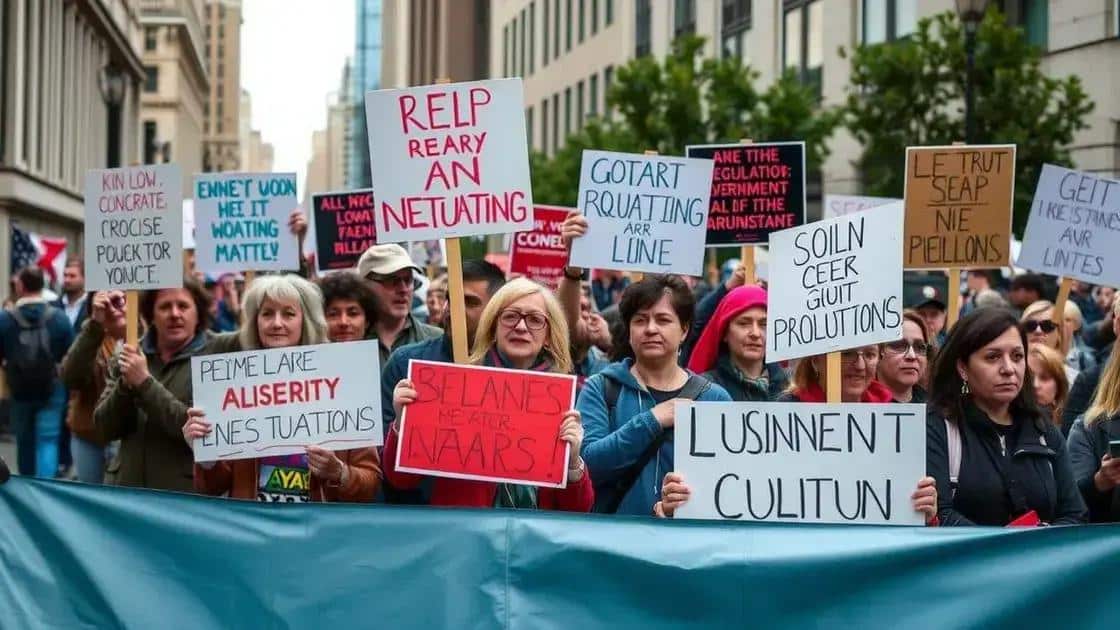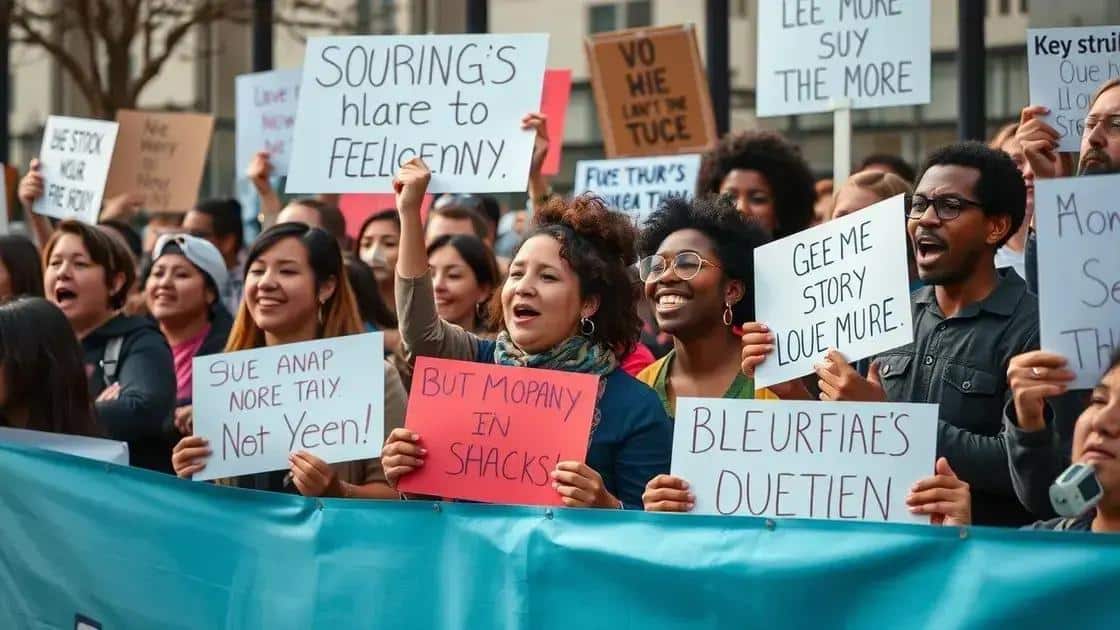Protesters rally in opposition to Trump-era regulations

Anúncios
Protesters rally in opposition to Trump-era regulations, voicing key concerns such as social justice, healthcare access, and environmental protection while influencing public policy and fostering community engagement.
Protesters rally in opposition to Trump-era regulations, with many seeking to address the controversies surrounding these policies. Have you wondered how these rallies might influence future policies?
Understanding the impact of Trump-era regulations
Understanding the impact of Trump-era regulations is crucial for grasping the current political and economic landscape. These regulations have shaped various sectors, influencing how businesses operate and how citizens engage with government policies.
Key Areas Affected
Several key areas have been notably affected by Trump-era regulations. Understanding these will provide clarity on the broader implications for society.
- Environmental Policies: The rollback of regulations has raised concerns about climate change.
- Healthcare Systems: Changes have affected access to care and insurance coverage.
- Labor Rights: New policies have impacted workers’ rights and protections.
- Trade Agreements: Regulations have altered international trade dynamics.
Shifted regulations have led to significant debates among lawmakers, citizens, and activists. As more protests arise, the public’s voice is becoming increasingly influential in shaping future policies. Understanding the nuances of these regulations can be complex, yet it is essential for informed discussion.
Economic Implications
The economic implications of these regulations are far-reaching. Businesses have had to adjust to new standards and compliance practices, which can be costly and time-consuming. For many small businesses, navigating these changes poses a significant challenge, especially in maintaining profitability.
How are workers feeling the effects? Employees are experiencing changes in workplace safety and rights, prompting protests advocating for better protections. The ongoing dialogue surrounding these issues highlights the significance of public sentiment in influencing potential changes to legislation.
As citizens advocate for changes, the impact of regulations on daily life becomes more pronounced. Not only do these regulations affect business operations, but they also shape societal norms and public reliance on government support and intervention.
Key concerns voiced by protesters

Understanding the key concerns voiced by protesters is essential to grasp the motivations behind their rallies. As people unite to express their discontent, several critical issues emerge that resonate with many citizens.
Major Issues Highlighted
Protesters are vocal about multiple issues that they believe need urgent attention. These concerns often reflect deeper societal problems and demand immediate government responses.
- Social Justice: Many protesters are advocating for equality and fair treatment for all individuals.
- Healthcare Access: Access to affordable healthcare remains a significant concern, especially in light of policy changes.
- Environmental Protection: Activists emphasize the need for stronger regulations to combat climate change and protect natural resources.
- Workers’ Rights: There is a strong push for better labor protections, reflecting frustrations with current working conditions.
As these concerns gain more visibility, it is evident that public opinion is a powerful force in shaping political action. Protesters are not just raising their voices; they are actively seeking change in laws and policies that affect everyday life.
Personal Experiences and Stories
Personal stories shared during protests often highlight the real-life implications of these issues. For example, many individuals recount experiences of unfair treatment or lack of access to basic necessities. These narratives contribute to a collective understanding of the struggles faced by numerous people in society.
The emotional weight of these experiences resonates deeply with many, fostering a sense of unity among protesters. By vocalizing their concerns, they aim to draw attention to pressing matters that affect their lives and the lives of others.
Ultimately, the concerns voiced by protesters reveal a significant desire for change and improvement. As these movements continue to grow, the emphasis remains on ensuring that the voices of the community are heard loud and clear.
The role of public opinion in shaping policy
The role of public opinion in shaping policy is a critical factor in governance. Policies are not created in a vacuum; they reflect the views and needs of the society they are meant to serve.
Influencing Decision-Makers
When citizens express their concerns, elected officials often feel pressured to respond. Public opinion acts as a guiding force, compelling policymakers to consider the viewpoints of constituents.
- Voting Patterns: Elections showcase how public sentiment influences which candidates succeed.
- Polls and Surveys: Regular polling helps gauge public perceptions and concerns, influencing legislative agendas.
- Media Coverage: News outlets often highlight public opinion, ensuring that issues remain in the public eye.
- Social Media: Platforms allow for rapid dissemination of opinions, impacting real-time political discourse.
As protests gain attention, they generate conversations around pressing issues. For instance, heightened activism can lead to policy shifts, as lawmakers react to the demands of their constituencies. The voices of citizens have the power to sway decisions and direct government actions.
Long-Term Impacts of Public Sentiment
Over time, consistent public opinion can lead to significant legislative changes. Fluctuations in sentiment may prompt lawmakers to reevaluate existing policies. This can result in either the strengthening or dismantling of regulations that were previously thought to be permanent.
Additionally, when people unite around a common cause, it can spark movements that reshape societal norms. Support for various social issues often stems from a collective understanding established through shared experiences and discussions.
The dynamic interplay between public opinion and policy creation highlights the importance of civic engagement. Healthy democracies thrive when citizens actively participate in dialogue about their rights and needs, ultimately shaping the foundation of their governance.
Possible outcomes of the ongoing protests

The possible outcomes of the ongoing protests are diverse and can significantly impact society and politics. As these movements gain traction, they create various paths for change.
Legislative Changes
One major outcome might be new laws or revisions to existing policies. When large groups of people voice their concerns, lawmakers often take notice. This can lead to:
- Updated Regulations: Changes that address specific issues raised during protests.
- Increased Funding: More resources allocated to social programs or public services that meet protesters’ demands.
- Policy Expansions: Broader definitions of what rights citizens possess or protections required by law.
- Awareness Campaigns: Initiatives that educate the public and policymakers about pressing issues.
Moreover, protests can shift the political landscape. Elected officials may feel compelled to support certain causes to align with public sentiment, which can lead to more progressive governance.
Social Mobilization
Beyond policy changes, protests often foster a sense of community and connection among participants. People come together in solidarity, sharing experiences and building networks. This mobilization can result in:
- Grassroots Organizations: Formation of community groups dedicated to advocacy and education.
- Long-Term Activism: Continued engagement of individuals in civic activities beyond initial protests.
- Awareness Raising: Increased public knowledge about systemic issues affecting society.
This mobilization creates a lasting impact, as individuals who participated often become lifelong advocates for change. Their stories and experiences can inspire others to join the cause.
Lastly, there are potential setbacks as well. Not all protests lead to immediate change, and some can result in backlash or increased repression. Understanding the multiple outcomes can help communities prepare for both challenges and victories in the ongoing fight for justice.
In conclusion, the ongoing protests reflect the concerns and aspirations of many individuals. As public voices grow stronger, they can lead to significant changes in policies and societal norms. The impact of these movements often extends beyond immediate outcomes, fostering lasting community engagement and awareness. By understanding the possible results of these protests, we can appreciate the power of collective action and its role in shaping our future. As activists advocate for social change, it becomes clear that their efforts are vital in steering the direction of policy and societal values.
FAQ – Frequently Asked Questions about Protests and Their Impact
What are the main concerns of protesters?
Protesters often voice concerns about social justice, healthcare access, environmental protection, and workers’ rights.
How do protests influence public policy?
Protests can lead to new laws and amendments by highlighting critical issues that policymakers must address to align with public sentiment.
What social changes can arise from protests?
Protests can foster community engagement, create grassroots organizations, and encourage long-term activism among participants.
Are there risks associated with protests?
Yes, protests can sometimes face backlash or resistance from authorities, which may complicate efforts for change.






